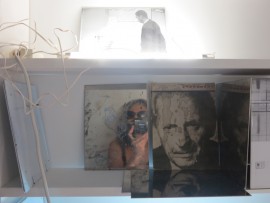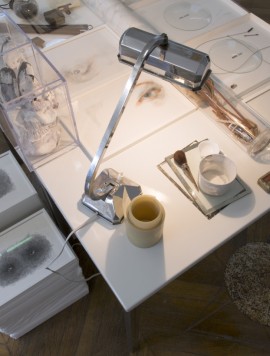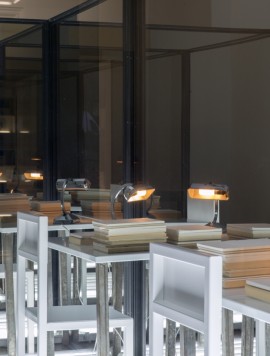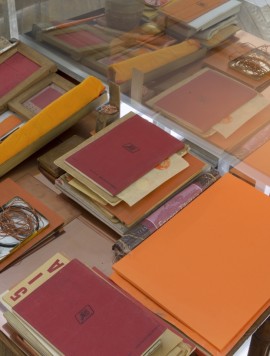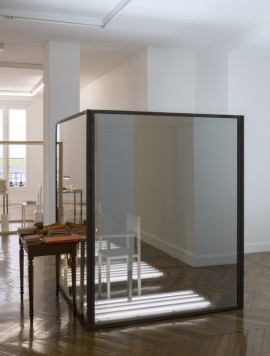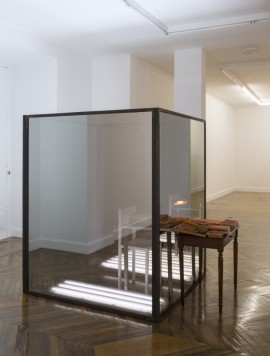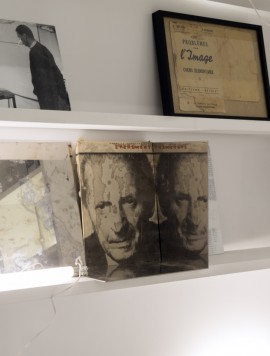Noyau dur et double foyer
Laura Lamiel started out in the early 1980s and, since then,
has continued to develop her work and make it more complex. In thirty years the oeuvre she has compiled is strong and systemic, with a pure and luminous, serial, absolute quality in which angles and whiteness dominate. Early on, she learned to escape this conceptual structure by integrating found objects–shopping trolleys, gloves, rolls of carpet, rubber ties, books, lights and electric wires–which brought a different dimension to the hard kernel (noyau dur) of her work; it took on a precariousness, a darkness, an interiority–shot through with contingencies and intuitive decisions. This plethora of imported elements, with their unsettled forms, irrupting into the simple, regular geometric spaces evokes a meeting of two artistic parangons: minimal art, with its sober, basic formal vocabulary, and arte povera, with its cheap materials and ephemeral nature. These two artistic traditions, heirs to the model of the “white cube”–a space long considered exemplary, neutral and untouchable–have come together to interrogate the effect of a break with the continuity of the real on the exhibition territory. Laura Lamiel overrides the denaturing role of the “white cube” and its estrangement effect on the context by entering fully into it.
Probably guided by an urge for autonomy, at a practical
and a symbolic, as well as aesthetic, level, Laura Lamiel defined her own tools for exhibition and documentation early in her career. For example, her cellules, consisting of three walls are all “white cubes” adapted to the size of her body and open on one side. They are basic exhibition spaces; they host an infinite number of potential compositions, giving order, within their immaculate, reflective walls, to objects showing signs of wear and tear. Like shelving under the glare of neon lights, they capture each found object in all its concrete truth and compel the spectator to attend to all the details and signs. The discarded objects themselves make up a network with no hierarchy, that is formal, sensitive and cultural. The width of the enamelled steel walls (1.30m) corresponds to the width of Lamiel’s outstretched arms, which means she can move them around by herself in her studio and assemble them easily with clamps and wooden wedges. But although the cellules feel welcoming, there is a certain meanness about them, like chairs or stools that are too rickety or too cluttered for anyone ever to sit on them properly. They inhibit anyone from entering, and this sets up a relationship with the visitor that is more hypothetical than concrete, such is the tension created by their equilibrium. They invite inspection but not physical contact. In this they perpetuate the triumph of looking intended by the “white cube”, but they bend the idea, making the visual aspect constantly clear through the private, personal dimension of the solitary eye, uncomfortable and aware of its position. The cellules are semi-autonomous objects. When there are several of them at regular intervals, they override their primary function as exhibition spaces to display themselves as sculptures in their own right, standing away from the wall. The inside of a cellule with its monochrome white surfaces offers itself for inspection from the front, while the outside of the cellule shows all the weaknesses of construction (rough surfaces, clamps and wedges), thus reworking an interplay of, on the one hand, the constructive dynamic of the work, which tends to positivism and an undermining of reality (the urge to show all in a dazzling light) and, on the other hand, the inherent fragility of it all.
While this cellular unit keeps the work relatively independent of any particular exhibition space, Laura Lamiel has elaborated her own system of documentation, thus extending the autonomy of her production. She takes photographs in her studio and at the exhibition, which she adds in all their flatness to the volumes of the cellules. The photographic shot becomes an integral part of the pictorial composition and the arrangement of the various volumes, rendering ever more complex the combinatory system of her installations. These photos are evidence of a stage in the work in the studio, and give added weight to past actions. Through this mise en abîme of actual space and pictured space, she further troubles the vision of the constructed spaces, adding a variable to them: namely, an inexhaustible stock of potential acts.
With the regularity of a project biased towards the exhaustion of all possible effects, Laura Lamiel gives us a destabilising experience. The affective side of her work pierces beyond the conceptual structure and gives the work a more intimate and intuitive turn. None of the pieces seems to be firmly fixed; they feel as if they are being looked at through bi-focal lenses (double foyer), with a tendency for disturbing mirror effects and skewed symmetries to creep into the picture.
The journal accompanying the exhibition is a visual essay. It mainly consists of photographs of the studio, and quotations from people who have reviewed the artist’s work over the years. It presents a studio process in progress, and reveals some of the principles underlying the exhibition.
Émilie Renard
Translated by Jeremy Harrison
around the exhibition
-
25/01/2014
From 3.30 pm to 7.30 pm
Eastside Tour #15, the East Paris contemporary art bus between la Maison populaire (Montreuil), La Galerie (Noisy-le-Sec) and Les Instants Chavirés welcomed by 116 (Montreuil).
Meet at 3.30 pm, at la Maison populaire (Metro Line 9, Mairie de Montreuil).—
Free (advance booking required): resa@parcours-est.com / www.parcours-est.com
-
08/02/2014
From 3 pm to 7 pm
Discreet guided tours with art critic Marie Cantos and gallerists/art critics Isabelle Alfonsi and Cécilia Becanovic.
